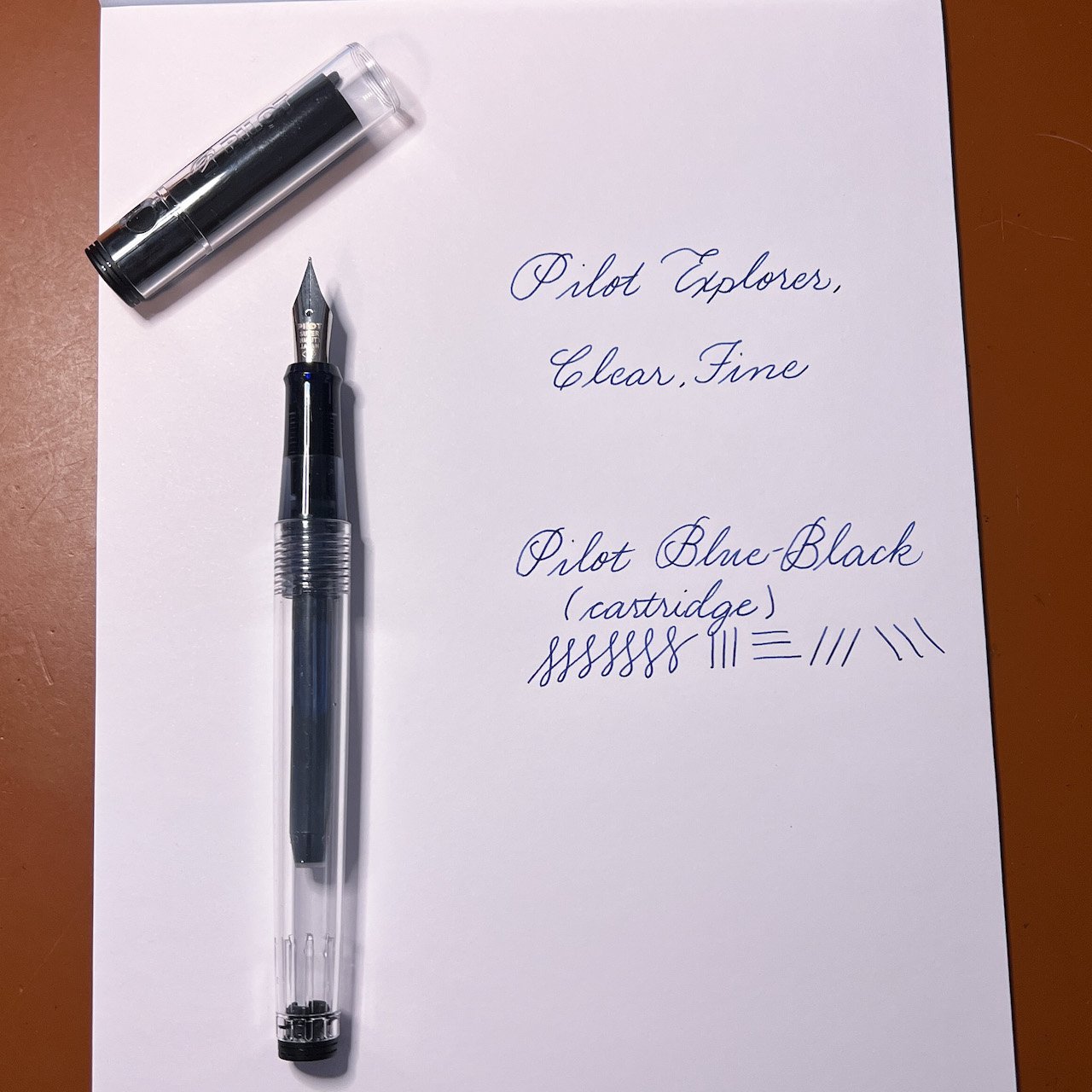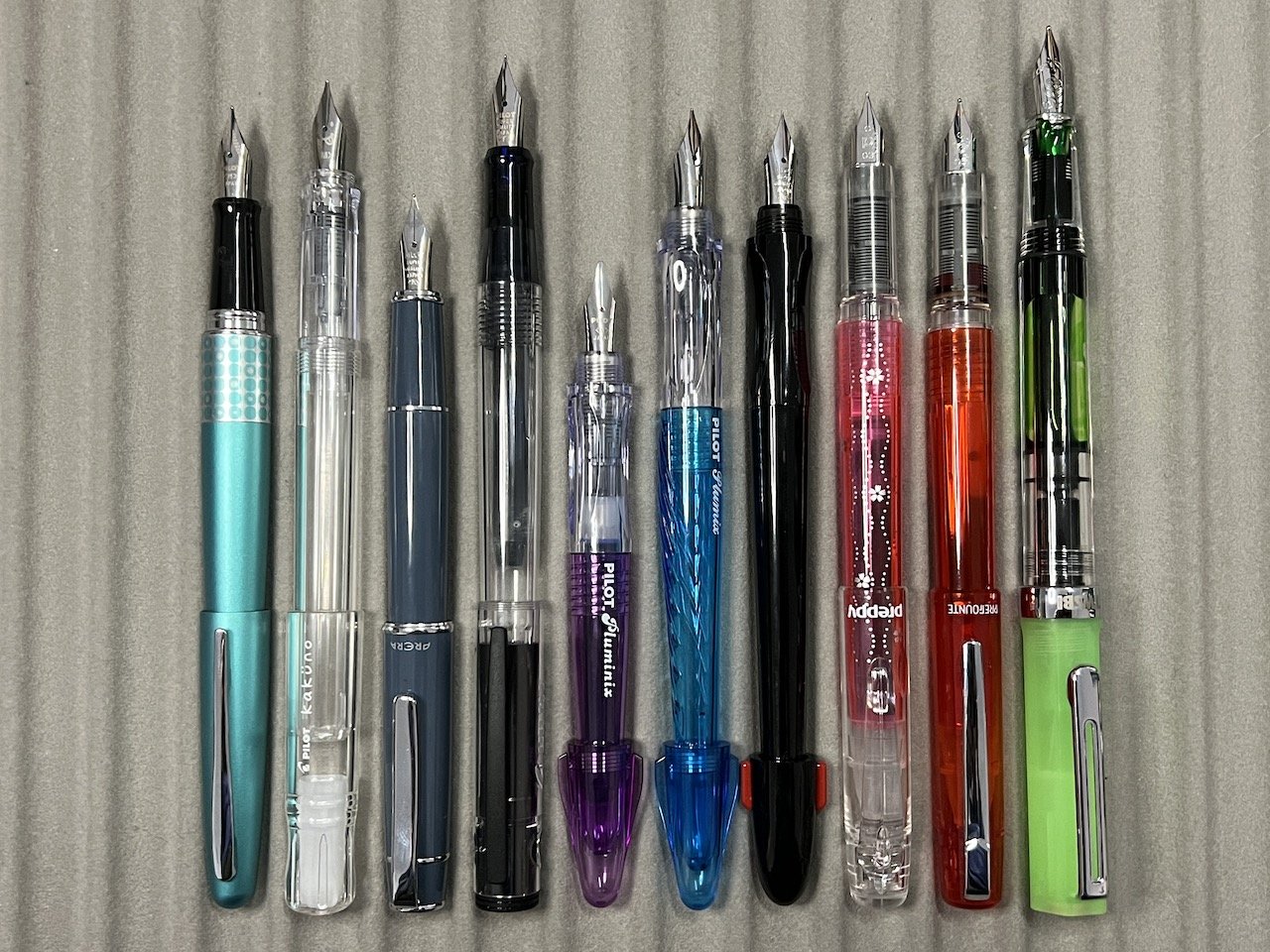(Kimberly (she/her) took the express train down the fountain pen/stationery rabbit hole and doesn't want to be rescued. She can be found on Instagram @allthehobbies because there really are many, many hobbies!.)
After almost 6 years in this rabbit hole, it may come as a surprise that I still enjoy “entry-level” or budget-friendly pens very much. I still use a Pilot Metropolitan every day to write the day/date in my bullet journal, while Platinum Preppies, Lamy Al-Stars (Team #AlStarAlways), and others are also in regular rotation. I’ve asked the Bossman to keep me in mind whenever these kinds of pens come up for review. And when Pen Chalet sent us the Pilot Explorer for review, I jumped at the opportunity.
Released in 2019, the Pilot Explorer enters a fairly crowded budget-friendly steel nibbed fountain pen field, especially since several of the pens in that field are also made by Pilot. Other Pilot pens in this range include the Kakuno, Plumix/Pluminix/Penmanship and of course, the Metropolitan (the Prera is just on the cusp of budget-friendliness).
The Pilot Explorer that I am reviewing today is the clear one, but it also comes in a total of 12 colors (hmm, is Clear a color?) ranging from Black Matte to Blue, Silver or Turquoise, etc. which are metallic finishes. All of them come with a black clip and black finials. The snap cap has an embossed Pilot brand and logo and inside is a black inner liner - which is very obvious with the Clear model - which prevents ink from drying out in the cap. After inking it and writing with it on/off for several weeks, I deliberately left this pen untouched for over a month - thank you, Fountain Pen Companion for keeping track of this - and it wrote up right away without any issue.
Hard to tell but the logo is the same color as the cap, which in this case, is clear.
The Pilot Explorer comes in a metal tin and depending on where you buy it, may or may not include a Con-B squeeze converter. (Tip: if it does include the Con-B, do yourself a favor and use anything else but that converter because you can’t see if there’s any ink in it, can’t tell if it’s clean, etc.) It can also fit the Con-40, Con-50 and is also long enough to use the Con-70 if you wish to do so (it’s my second least favorite converter). Resist the urge to eyedropper this pen because there are small holes/gaps at the base of the barrel which will leak - I’m glad I tested this with water over my dump cup because the leak was immediate and messy, lol.
It comes in Fine and Medium nib sizes and is the same size steel nib as the Pilot Metropolitan, Plumix/Pluminix, Penmanship, Prera; and Kakuno (though the Kakuno has irresistibly cute faces on it), and they are interchangeable if you wanted to swap nibs. Just gently pull the nib/feed straight out to remove them. This means that the writing experience will be the same as with the other models if you’ve already tried them before. This one is a Fine and writes just like my Metropolitan Fine which I use every day. I inked the Explorer up with a Pilot Mixable Blue Black cartridge and it wrote right away without any issue. As expected, the writing experience is good - the nib is firm, no flex, and the nib lays down a fine line without being scratchy.
Yup, writes just like a Pilot steel nib fountain pen should.
The Pilot Explorer and Kakuno are the two pens in the steel lineup that are the most similar to each other. The Explorer weighs in at 0.42 ounces (11.9g), with the cap weighing 0.20 oz (5.39g) and the rest without converter or cartridge is 0.22 oz (6.24g). The Kakuno is 0.39 oz (11g), cap 0.13 oz (3.69g) and the pen 0.26 oz (7.37g). The Metro is almost double the weight.
Left to Right: Pilot Kakuno, Explorer, Metropolitan - you can see that the Kakuno’s grip section is a little girthier than the other two.
The Explorer and Metropolitan have more similar grips. Both are flared near the nib to prevent your fingers from sliding forward. The Explorer does not have the step near the barrel that the Metro does - this step is one of the things that some users don’t like about the Metro. The Kakuno, Metro and Explorer all have snap caps.
Comparison L to R: Pilot Metropolitan, Pilota Kakuno, Pilot Prera, Pilot Explorer, Pilot Pluminix, Pilot Plumix, Pilot Penmanship, Platinum Preppy, Platinum Prefounte, TWSBI Eco.
The Pilot Explorer retails for $25, and whether a Con-20 or Con-B is included is up to the retailer, so be sure to check what is/is not included with your purchase. The Kakuno, on the other hand, sells for around $15. The Kakuno doesn’t have a clip, doesn’t include a converter and its color combinations may not look and feel as “professional” as the Explorer but I’m not sure that either of those things justify the near double price tag. I will admit that comparing two Clear pens doesn’t help the Explorer because the metallic finish does look and feel nicer than the plastic versions. The Explorer is priced about the same as the Metropolitan, which feels much more substantial and has a more traditional style, and also the TWSBI Swipe or Eco, both of which have a much larger ink capacity.
All in all, the Pilot Explorer is a good pen, but at its price point, it really doesn’t compete with the Pilot Metropolitan in looks and heft or with the TWSBI Eco in function and ink capacity. Nor does it compete in price with its cuter sibling, the Kakuno or with the Platinum Preppy or Prefounte. But if you like how the Metro writes, but don’t like the step or the weight (or both), the Explorer might be the pen for you.
(Pen Chalet provided this product at no charge to The Pen Addict for review purposes.)











